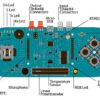+251 99 380 2995 | +251 97 022 2227 | [email protected]




Arduino Esplora
Br 6,500.00
- Microcontroller: ATmega32u4
- Operating Voltage: 5V
- Flash Memory: 32 KB of which 4 KB used by bootloader
- SRAM: 2.5 KB
- EEPROM: 1 KB
- Clock Speed: 16MHz
- Length: 164.04mm
- Width: 60mm
The Esplora has the following on-board inputs and outputs :
- Analog joystick with central push-button two axis (X and Y) and a center pushbutton.
- 4 push-buttons laid out in a diamond pattern.
- Linear potentiometer slider near the bottom of the board.
- Microphone for getting the loudness (amplitude) of the surrounding environment.
- Light sensor for getting the brightness.
- Temperature sensor reads the ambient temperature
- Three-axis accelerometer measures the board’s relation to gravity on three axes (X, Y, and Z)
- Buzzer can produce square-waves.
- RGB led bright LED with Red Green and Blue elements for color mixing.
- 2 TinkerKit Inputs to connect the TinkerKit sensor modules with the 3-pin connectors.
- 2 TinkerKit Outputs to connect the TinkerKit actuator modules with the 3-pin connectors.
- TFT display connector connector for an optional color LCD screen, SD card, or other devices that use the SPI protocol.
In order to utilize the total number of available sensors, the board uses an analog multiplexer. This means a single analog input of the microcontroller is shared among all the input channels (except the 3-axis accelerometer). Four additional microcontroller pins choose which channel to read.
- Arduino Esplora Board
- The Arduino Esplora is an Arduino Leonardo based board with integrated sensors and actuators
- The design of the Esplora board recalls traditional gamepad design with an analog joystick on the left and four pushbuttons on the right.
- The Arduino Esplora is a microcontroller board derived from the Arduino Leonardo. The Esplora differs from all preceding Arduino boards in that it provides a number of built-in, ready-to-use set of onboard sensors for interaction. It’s designed for people who want to get up and running with Arduino without having to learn about the electronics first.
- The Esplora has onboard sound and light outputs, and several input sensors, including a joystick, a slider, a temperature sensor, an accelerometer, a microphone, and a light sensor. It also has the potential to expand its capabilities with two Tinkerkit input and output connectors, and a socket for a color TFT LCD screen.
- Like the Leonardo board, the Esplora uses an Atmega32U4 AVR microcontroller with 16 MHzcrystal oscillator and a micro USB connection capable of acting as a USB client device, like a mouse or a keyboard.
- The board contains everything needed to support the microcontroller; simply connect it to a computer with a USB cable to get started.
- The Esplora has built-in USB communication; it can appear to a connected computer as a mouse or keyboard, in addition to a virtual (CDC) serial / COM port.
- The ATmega32u4 has 32 KB (with 4 KB used for the bootloader). It also has 2.5 KB of SRAM and 1 KB of EEPROM (which can be read and written with the EEPROM library).
In the upper left corner of the board there is a reset pushbutton, that you can use to restart the board. There are four status LEDS:
- ON [green] indicates whether the board is receiving power supply
- L [yellow] connected directly to the microcontroller, accessible through pin 13
- RX and TX [yellow] indicates the data being transmitted or received over the USB communication








